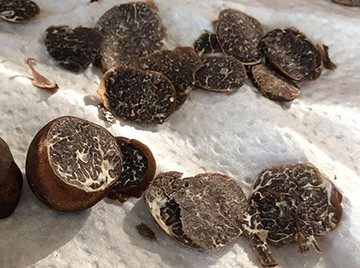FOR IMMEDIATE RELEASE | September 08, 2022
What makes the ‘Appalachian truffle’ taste and smell delicious
“Characterization of the Volatilome of Tuber canaliculatum Harvested in Quebec, Canada”
ACS Omega
A hallmark of a truly luxurious meal is a sprinkling of truffle shavings — the fungal kind, not the chocolate. Nicknamed “diamonds” of the culinary world, these fanciful fungi are prized for their unique flavor and scent. But newer truffle species are fighting to achieve that same gourmet status. Now, researchers reporting in ACS Omega have performed the first full aroma characterization of the Appalachian truffle, unlocking the potential for a new North American “black diamond.”
The gourmet delicacies known as truffles are subterranean fungi of the Tuber species that require several years and very particular conditions to grow. Figuring out how to cultivate the fungi efficiently has been very difficult, so most people forage for them in the wild using trained animals, such as pigs or dogs, that can uncover these hidden gems. Because truffles are so rare and challenging to obtain, they are very expensive. For example, a large 3.3-pound behemoth from Italy cost $330,000 at auction several years ago. Commercial truffles most often originate from Europe, Australia and the western U.S., but different species exist all over the world. Unlike the fancy white or black truffles grown in Italy or France, however, many unearthed in North America have not been well studied. So, Normand Voyer and colleagues wanted to thoroughly analyze the aromatic profile of one of these North American varieties, known as Tuber canaliculatum, or Appalachian truffle.
To accomplish this, the researchers investigated three T. canaliculatum samples using headspace solid-phase microextraction (HS-SPME) and gas chromatography-mass spectrometry (GC/MS). With these techniques, the team identified the species’ “volatilome,” or the chemical fingerprint responsible for its aroma. A total of 30 different compounds, including six that had never been reported in other truffle species, were identified. Some, such as 2,4-dithiapentane, are found in many truffle species and give truffle oil its unique smell. The most prevalent compounds were described as having strong odors of garlic, fungus and even a cabbage-like, rotten smell that was found in higher concentrations in older samples. The researchers say that this work could spur future studies of T. canaliculatum, which might one day place it at the same high status as its European cousins.
The authors acknowledge funding from the Natural Science and Engineering Research Council of Canada and the Fonds de Recherche du Québec-Nature et Technologies.
To automatically receive press releases from the American Chemical Society, contact newsroom@acs.org.
Note: ACS does not conduct research, but publishes and publicizes peer-reviewed scientific studies.
Media Contact
ACS Newsroom
newsroom@acs.org


